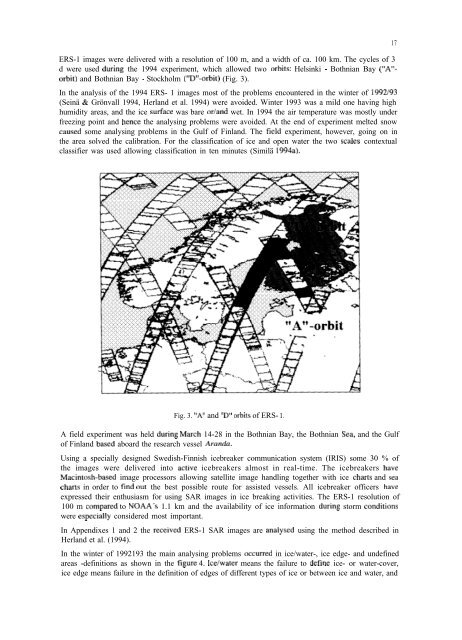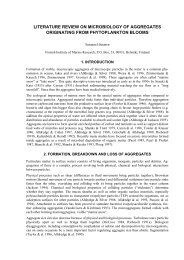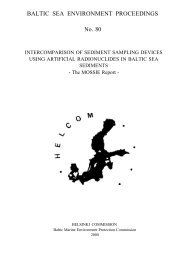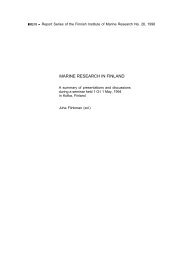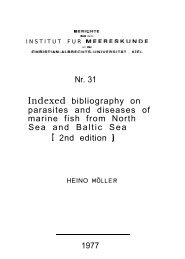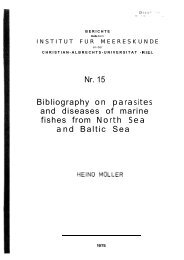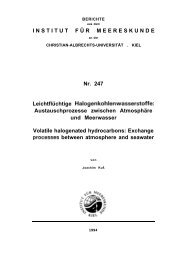the numerical sea ice forecast in finland in the winter 1993-94 ...
the numerical sea ice forecast in finland in the winter 1993-94 ...
the numerical sea ice forecast in finland in the winter 1993-94 ...
- No tags were found...
Create successful ePaper yourself
Turn your PDF publications into a flip-book with our unique Google optimized e-Paper software.
ERS-1 images were delivered with a resolution of 100 m, and a width of ca. 100 km. The cycles of 3<br />
d were used dur<strong>in</strong>g <strong>the</strong> 19<strong>94</strong> experiment, which allowed two orbits: Hels<strong>in</strong>ki - Bothnian Bay (“A”-<br />
orbit) and Bothnian Bay - Stockholm (“Dl’-orbit) (Fig. 3).<br />
In <strong>the</strong> analysis of <strong>the</strong> 19<strong>94</strong> ERS- 1 images most of <strong>the</strong> problems encountered <strong>in</strong> <strong>the</strong> w<strong>in</strong>ter of 1992/93<br />
(Se<strong>in</strong>ä & Grönvall 19<strong>94</strong>, Herland et al. 19<strong>94</strong>) were avoided. W<strong>in</strong>ter <strong>1993</strong> was a mild one hav<strong>in</strong>g high<br />
humidity areas, and <strong>the</strong> <strong>ice</strong> surface was bare or/and wet. In 19<strong>94</strong> <strong>the</strong> air temperature was mostly under<br />
freez<strong>in</strong>g po<strong>in</strong>t and hence <strong>the</strong> analys<strong>in</strong>g problems were avoided. At <strong>the</strong> end of experiment melted snow<br />
caused some analys<strong>in</strong>g problems <strong>in</strong> <strong>the</strong> Gulf of F<strong>in</strong>land. The field experiment, however, go<strong>in</strong>g on <strong>in</strong><br />
<strong>the</strong> area solved <strong>the</strong> calibration. For <strong>the</strong> classification of <strong>ice</strong> and open water <strong>the</strong> two scales contextual<br />
classifier was used allow<strong>in</strong>g classification <strong>in</strong> ten m<strong>in</strong>utes (Similä 19<strong>94</strong>a).<br />
17<br />
Fig. 3. “A” and “D” orbits of ERS- 1.<br />
A field experiment was held dur<strong>in</strong>g March 14-28 <strong>in</strong> <strong>the</strong> Bothnian Bay, <strong>the</strong> Bothnian Sea, and <strong>the</strong> Gulf<br />
of F<strong>in</strong>land based aboard <strong>the</strong> re<strong>sea</strong>rch vessel Aranda.<br />
Us<strong>in</strong>g a specially designed Swedish-F<strong>in</strong>nish <strong>ice</strong>breaker communication system (IRIS) some 30 % of<br />
<strong>the</strong> images were delivered <strong>in</strong>to active <strong>ice</strong>breakers almost <strong>in</strong> real-time. The <strong>ice</strong>breakers have<br />
Mac<strong>in</strong>tosh-based image processors allow<strong>in</strong>g satellite image handl<strong>in</strong>g toge<strong>the</strong>r with <strong>ice</strong> charts and <strong>sea</strong><br />
charts <strong>in</strong> order to f<strong>in</strong>d out <strong>the</strong> best possible route for assisted vessels. All <strong>ice</strong>breaker off<strong>ice</strong>rs have<br />
expressed <strong>the</strong>ir enthusiasm for us<strong>in</strong>g SAR images <strong>in</strong> <strong>ice</strong> break<strong>in</strong>g activities. The ERS-1 resolution of<br />
100 m compared to NOAA’s 1.1 km and <strong>the</strong> availability of <strong>ice</strong> <strong>in</strong>formation dur<strong>in</strong>g storm conditions<br />
were especially considered most important.<br />
In Appendixes 1 and 2 <strong>the</strong> received ERS-1 SAR images are analysed us<strong>in</strong>g <strong>the</strong> method described <strong>in</strong><br />
Herland et al. (19<strong>94</strong>).<br />
In <strong>the</strong> w<strong>in</strong>ter of 1992193 <strong>the</strong> ma<strong>in</strong> analys<strong>in</strong>g problems occurred <strong>in</strong> <strong>ice</strong>/water-, <strong>ice</strong> edge- and undef<strong>in</strong>ed<br />
areas -def<strong>in</strong>itions as shown <strong>in</strong> <strong>the</strong> figure 4. Ice/water means <strong>the</strong> failure to def<strong>in</strong>e <strong>ice</strong>- or water-cover,<br />
<strong>ice</strong> edge means failure <strong>in</strong> <strong>the</strong> def<strong>in</strong>ition of edges of different types of <strong>ice</strong> or between <strong>ice</strong> and water, and


